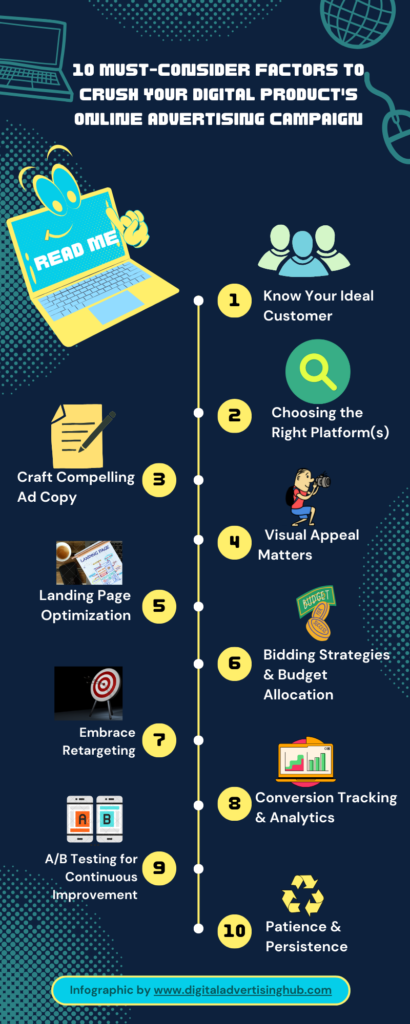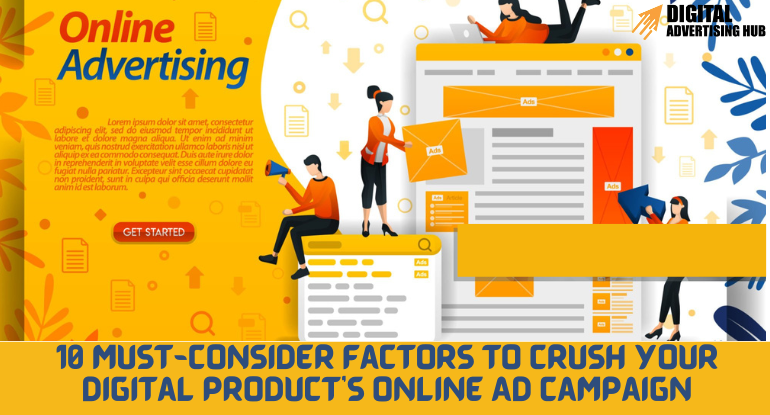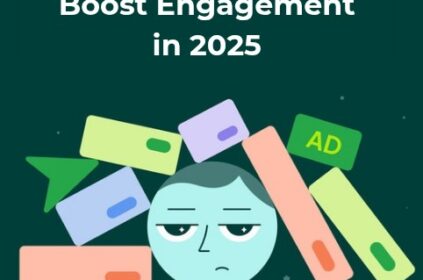Have you ever launched a great digital product but struggled to make any sales?
We’ve all been there. You’ve poured your resources into building something amazing, but reaching the right audience online can feel like a never-ending quest.
The good news? Online advertising is your secret weapon for bridging that gap and getting your product into the hands of eager customers. Imagine targeted ads reaching the exact demographic you designed for, with messaging that speaks directly to their needs and eye-catching visuals that grab their attention.
That’s the power of a well-crafted online advertising campaign in action.
But here’s the catch: it’s not just about throwing some ads out there and hoping for the best. It’s a strategic approach that involves understanding your audience, choosing the right platforms, crafting compelling content, and constantly optimizing based on data.
To ensure your digital advertising campaign hits the mark, we’ve outlined 10 essential factors you can’t afford to overlook when crafting your online ad strategy for a digital product.
By honing in on these elements, you’ll turn your campaign into a powerhouse that draws in your ideal audience and boosts your conversion rates through the roof. Let us explore these 10 key considerations that are bound to propel your digital product to success!

1. Know Your Ideal Customer
Before creating online advertising campaigns, pause for a moment and immerse yourself in the world of your perfect customer. While it may seem like a simple step, it is often overlooked, leading to campaigns that miss the mark.
Clearly defining your target audience sets the stage for success and ensures your efforts resonate with the right people. Here’s why this is crucial:
#1. Laser-Focused Targeting: By understanding your ideal customer’s demographics (age, location, income), interests (hobbies, online behavior), and pain points (problems your product solves), you can tailor your ads to resonate with them directly. This increases the chances of your message getting noticed and understood.
#2. Maximized Budget: Advertising platforms allow you to target specific demographics and interests. Knowing your ideal customer ensures you’re not wasting your budget reaching irrelevant audiences.
#3. Effective Messaging: Crafting compelling ad copy requires understanding your audience’s needs and desires. Once you know what makes them tick, you can develop messaging that speaks directly to their problems and highlights how your product offers the perfect solution.
How to Find Your Ideal Customer
#1. Buyer Personas: Develop detailed buyer personas that represent your ideal customer. These profiles should incorporate demographics, interests, online behavior, and challenges they face.
Imagine you’re a company selling high-quality hiking gear. To develop detailed buyer personas, you’d create profiles that represent your ideal customers. Let’s say you identify two primary personas:
i. Adventurous Andy:
– Demographics: Male, aged 25-35
– Interests: Outdoor activities, hiking, camping, nature photography
– Online Behavior: Actively follows outdoor adventure blogs and social media accounts, frequently searches for hiking trails and camping gear online
– Challenges: Struggles to find durable hiking gear that withstands rugged terrain, seeks gear that balances performance and affordability
ii. Nature-loving Nancy:
– Demographics: Female, aged 30-45
– Interests: Nature conservation, eco-friendly products, family-friendly outdoor activities
– Online Behavior: Engages with environmental advocacy groups on social media, searches for sustainable outdoor gear options, reads family travel blogs
– Challenges: Looks for hiking gear that aligns with her eco-conscious values, desires products suitable for family outings and outdoor adventures with kids
By creating these detailed buyer personas, you gain valuable insights into the characteristics, preferences, and pain points of your target audience. This allows you to tailor your marketing efforts and product offerings to better meet their needs and aspirations.
#2. Market Research: Another way to find your ideal customer is to conduct market research which allows you to understand your target audience and their online habits. Utilize surveys, social media listening tools, and competitor analysis to gather insights.
#3. Customer Data Analysis: If you have existing customers, analyze their data to identify trends and commonalities. This can provide valuable insights into your ideal customer profile.
By investing time in understanding your ideal customer, you lay the foundation for a successful online advertising campaign. Remember, the more you know about your target audience, the more effectively you can reach them and convert them into loyal customers.
2. Choosing the Right Platform(s): Where Your Audience Lives Online
Imagine shouting your message into a crowded train station, hoping your ideal customer is listening. That’s what happens when you choose the wrong platform for your online advertising campaign.
The key is to be strategic and target your ads on the platforms where your ideal customer spends their time online.
Here’s a breakdown of some popular advertising platforms and how they can align with your product:
#1. Search Engines (Google Ads): Perfect for reaching users actively searching for products or services related to yours. Leverage keyword research to target specific search terms.
#2. Social Media (Facebook Ads, Instagram Ads): Great for reaching a broad audience based on demographics and interests. Platforms like Facebook offer powerful targeting options, while Instagram excels with visually appealing content for a younger demographic. Read about the 4 Powerful Social Media Platforms for Brands.
#3. Niche Communities (Industry Forums, Online Publications): Ideal for B2B products or those targeting specific interests. Target ads on relevant online communities and forums where your ideal customer interacts and seeks information.
Tips for Choosing the Right Platform
- Target Audience: Consider where your ideal customer spends their time online. Research platform demographics and user behavior to ensure alignment.
- Product Type: Match your product type with the platform’s strengths. Visually-appealing products might thrive on Instagram, while technical B2B solutions could find success on industry publications.
- Campaign Goals: Are you aiming for brand awareness, website traffic, or direct sales? Different platforms cater to various goals.
By carefully selecting the platforms your target audience frequents, you increase the chance of your ad resonating with them. Remember, it’s not about being everywhere; it’s about being present in the right places at the right time.
3. Craft Compelling Ad Copy: Speak the Language of Your Audience
Imagine a billboard with a blurry image and a cryptic message. Not exactly attention-grabbing, right? The same goes for your online ad copy. In the digital age, where users are bombarded with information, your ad copy needs to be clear, concise, and most importantly, compelling.
Here’s why crafting effective ad copy matters:
#1. First Impressions Matter: Your ad copy is often the first interaction a potential customer has with your product. Strong copy grabs their attention, communicates value, and motivates them to click on your ad.
#2. Benefits Over Features: Don’t just list features; focus on the benefits your product offers. Explain how it solves a problem or improves the user’s life.
#3. Call to Action is important: Tell users what you want them to do after seeing your ad. A clear and strong call to action (CTA) like “Learn More,” “Download Now,” or “Buy Now” is crucial for driving conversions.

Crafting Winning Ad Copy
#1. Focus on Benefits: Highlight how your product solves a specific problem or makes the user’s life easier.
#2. Keep it Short and Sweet: People skim online, so get your message across quickly and clearly.
#3. Use Strong Verbs and Power Words: Action verbs and words that evoke emotions like “easy,” “powerful,” or “limited-time” can grab attention and create a sense of urgency.
#4. Write in a Conversational Tone: Speak directly to your ideal customer, avoiding overly technical jargon.
#5. Include a Clear Call to Action: Tell users what you want them to do next, whether it’s visiting your website, downloading a free trial, or making a purchase.
By crafting compelling ad copy that speaks directly to your target audience, you can turn passive viewers into engaged customers. Remember, your ad copy is your elevator pitch – make it count! Read more on the Secrets of Effective Copywriting.
4. Visual Appeal Matters: Stop Scrolling, Start Clicking
There is a saying that a picture is worth a thousand words. That’s where the power of visuals comes into play for your online ad campaign. High-quality images, videos, and creative assets can make or break your ad’s success.
Here’s why visual appeal matters:
#1. Attention Grabbing: In a sea of text-based ads, a visually compelling image or video can instantly grab attention and stop users from scrolling past.
#2. Emotional Connection: Visuals can evoke emotions and create a lasting impression. A well-crafted image can build trust and brand association with your product.
#3. Storytelling Power: A single image or short video can tell a powerful story about your product and its benefits.
How to Optimize Your Visuals
#1. High-Quality Images and Videos: Invest in professional-looking visuals or high-quality stock photos and videos that align with your brand image.
#2. Relevance to Your Product: Choose visuals that directly represent your product and its benefits. Don’t use generic or misleading images.
#3. A/B Testing: Test different visuals to see what resonates best with your audience. Use A/B testing tools offered by advertising platforms to identify the most effective visuals for your campaign.
By incorporating high-quality and relevant visuals into your ad campaign, you increase the chances of capturing user attention, sparking interest, and ultimately driving clicks and conversions. Visuals are a powerful tool for storytelling and emotional connection – use them to your advantage!
5. Landing Page Optimization: The Seamless Journey from Ad Click to Conversion
Imagine a captivating ad that entices a user to click, only to land them on a confusing or poorly designed webpage. Not exactly the recipe for success, right? Your landing page, the destination users reach after clicking your ad, plays a crucial role in converting interest into action.
Here’s why landing page optimization is essential:
#1. Seamless User Experience: Your landing page should be a seamless continuation of the message conveyed in your ad. A confusing or cluttered landing page can lead to user frustration and missed conversion opportunities.
#2. Clarity and Focus: Landing pages should be laser-focused on a single goal, whether it’s a sale, a download, or a subscription. Eliminate distractions and keep the user journey clear and concise.
#3. Value Proposition Reigns Supreme: Clearly communicate the value proposition of your product on your landing page. Why should the user take action? What benefits will they gain?
Optimizing Your Landing Page:
#1. Align with Your Ad Message: Ensure the messaging and visuals on your landing page directly connect to the content of your ad.
#2. Clear Value Proposition: Present a strong and concise value proposition that highlights the benefits of your product.
#3. Compelling Call to Action: Include a clear and prominent call to action (CTA) that tells users exactly what you want them to do next.
#4. Minimize Friction: Streamline the conversion process by keeping forms short and user-friendly.
#5. Mobile-Friendly Design: Ensure your landing page is optimized for mobile devices, as a significant portion of users will access it from smartphones or tablets.
By optimizing your landing page for user experience and clear conversion goals, you bridge the gap between a captivating ad and a successful conversion. It should be highly noted that your landing page is the final step in your user journey – make it a smooth and rewarding experience! Learn more about how to design an Engaging Landing Page.
6. Bidding Strategies & Budget Allocation: Mastering the Art of Efficiency in Online Advertising
Imagine throwing money at an online advertising campaign without a clear strategy. That’s what happens when you don’t have a grasp on bidding strategies and budget allocation.
These two elements work hand-in-hand to ensure you’re getting the most out of your advertising budget and reaching the right audience at the right price.
Bidding Strategies:
- Essentially, you determine the maximum amount you’re willing to pay for a click, conversion, or impression on your ad.
- Different bidding strategies cater to various campaign goals:
- Cost-per-Click (CPC): You set a maximum bid for each click on your ad. Ideal for driving website traffic and brand awareness.
- Cost-per-Acquisition (CPA): You set a target cost for each conversion (e.g., sale, download). This strategy prioritizes acquiring new customers within your budget limit.
- Target Return On Ad Spend (TROAS): You set a target return on investment for your ad spend. This strategy maximizes your revenue or conversion value based on your budget.
Budget Allocation:
#1. Here, you decide how to distribute your advertising budget across different campaigns, ad groups, and even placements within a platform.
#2. Effective allocation considers factors like:
- Campaign Performance: Allocate more budget to high-performing campaigns or ad groups that are generating strong results.
- Audience Targeting: Adjust budget allocation based on the potential value of different audience segments.
- Campaign Goals: Prioritize budget allocation based on your overall campaign goals.
Optimizing Bidding and Budget:
#1. Start with Goals: Define your campaign goals (clicks, conversions, sales) before setting bidding strategies.
#2. Utilize Platform Tools: Most advertising platforms offer automated bidding options that can optimize bids based on your goals and performance data.
#3. Monitor and Adjust: Regularly monitor campaign performance and adjust your bidding strategies and budget allocation as needed.
By mastering bidding strategies and budget allocation, you can ensure your online advertising campaign operates efficiently. You’ll reach the right audience at the right price, maximizing your return on investment and achieving your desired marketing goals.
7. Embrace Retargeting: The Art of the Rebound and Conversion
They say there are plenty of fish in the sea, but what about the ones who nibbled on your bait and then swam away? In the world of online advertising, those are the website visitors who checked out your product but didn’t convert. But fear not, because retargeting exists to help you reel them back in!
Retargeting, also known as remarketing, is a powerful online advertising strategy that allows you to reconnect with users who have previously interacted with your website or mobile app. Here’s why it’s a game-changer:
#1. Second Chances: Retargeting lets you remind website visitors about your product after they’ve left your site. It keeps your brand top-of-mind and increases the likelihood of conversion on a future visit.
#2. Highly Targeted Ads: You can tailor your retargeting ads to be highly relevant to the specific actions users took on your website. For instance, someone who browsed a specific product can be shown a retargeting ad featuring that product with a special offer.
#3. Increased Brand Awareness: Retargeting keeps your brand visible to potential customers, even after their initial interaction. This builds brand recognition and trust, ultimately influencing their purchasing decisions.
Making Retargeting Work for You
#1. Track Website Visitors: Utilize retargeting pixels or website tags to track user behavior and build audience segments for retargeting campaigns.
#2. Segment Your Audience: Create targeted retargeting campaigns based on user behavior. For example, target users who abandoned their shopping carts with cart abandonment recovery ads.
#3. Compelling Creatives: Design engaging retargeting ads that showcase the benefits of your product and incentivize users to return and complete their purchase.
#4. Offer Incentives: Consider including special offers or discounts in your retargeting ads to entice users to convert.
By embracing retargeting, you unlock a powerful tool to re-engage website visitors and turn them into loyal customers. Remember, sometimes the key to success is a well-timed reminder and a nudge in the right direction.
8. Conversion Tracking & Analytics: Illuminating the Path to Success

Imagine driving a car blindfolded – reaching your destination would be a pure stroke of luck. The same applies to online advertising campaigns. Without conversion tracking and analytics, you’re essentially operating in the dark, unsure of what’s working and what’s not.
Here’s why conversion tracking and analytics are crucial:
#1. Measuring Success: Conversion tracking helps you measure the effectiveness of your campaign by identifying how many users take a desired action, such as a purchase, signup, or download.
#2. Data-Driven Optimization: Analytics provide valuable data insights into user behavior, ad performance, and overall campaign effectiveness. This data empowers you to identify what’s working, what’s not, and make informed decisions for optimization.
#3. Unlocking Hidden Gems: Analytics can reveal valuable insights you might not have anticipated. For instance, you might discover a specific ad or platform generating unexpectedly high conversions.
Conversion Tracking Essentials
#1. Define Conversions: Clearly define what constitutes a conversion for your campaign. This could be a purchase, a lead form submission, or a free trial sign-up.
#2. Implement Tracking Tools: Most advertising platforms offer built-in conversion tracking tools. You can also utilize tools like Google Analytics to track website conversions.
#3. Monitor Key Metrics: Track key metrics like clicks, impressions, conversion rate, and cost-per-acquisition (CPA) to understand campaign performance.
Leveraging Analytics for Optimization
#1. A/B Testing: Test different ad variations, landing pages, and targeting options to see which ones perform best in terms of conversions.
#2. Identify Trends: Analyze user behavior data to identify trends and patterns, allowing you to tailor your campaign for better results.
#3. Refine Targeting: Utilize analytics data to refine your audience targeting and ensure you’re reaching the right people.
By implementing conversion tracking and leveraging analytics, you gain invaluable insights into your campaign’s performance. This data becomes your guiding light, illuminating the path to successful optimization and ultimately, achieving your marketing goals. Remember, data is your friend – use it to your advantage!
9. A/B Testing for Continuous Improvement
Imagine launching a meticulously crafted ad campaign, only to see results plateau after a while. The digital advertising landscape is dynamic, and what works today might not be optimal tomorrow. That’s where A/B testing comes in – your secret weapon for continuous improvement.
A/B testing is a controlled experiment where you compare two variations of an ad element (headline, image, landing page) to see which one performs better. Here’s how it fuels campaign success:
#1. Uncover Hidden Gems: You might not always know what resonates best with your audience. A/B testing allows you to objectively compare different ad variations and identify unexpected winners.
#2. Data-Driven Decisions: A/B testing removes guesswork from the equation. Data reveals which elements resonate most with your audience, allowing you to optimize your campaign for better results.
#3. Continuous Refinement: The beauty of A/B testing lies in its iterative nature. You can continuously test and refine different aspects of your campaign, ensuring it remains optimized for peak performance.
A/B Testing in Action
#1. Choose Your Variable: Select a specific element of your ad or landing page to test (e.g., headline, call to action button color).
#2. Create Variations: Develop slightly different versions of the chosen element.
#3. Run the Test: Split your target audience and show each variation to a portion of the users.
#4. Analyze the Results: Track key metrics like click-through rates or conversions to identify the best-performing variation.
A/B Testing Best Practices
#1. Start Small: Begin with testing a single element at a time to isolate the impact of the change.
#2. Statistical Significance: Ensure you gather enough data to draw statistically significant conclusions from your tests.
#3. Test Consistently: A/B testing is an ongoing process. Continuously test and refine your campaign elements to maintain optimal performance.
By embracing A/B testing, you embark on a journey of continuous improvement for your online advertising campaign. Remember, the best campaigns are never truly finished – they constantly evolve based on data and insights, ensuring they stay ahead of the curve and deliver exceptional results.
10. Patience & Persistence: The Fuel for Long-Term Success
Imagine sprinting out of the starting gate in a marathon – you might have initial energy, but it won’t last the long haul. The same applies to online advertising campaigns. While you might crave instant results, achieving lasting success requires a healthy dose of patience and persistence.
Here’s why these qualities are essential:
#1. Optimization Takes Time: Don’t expect overnight success. Optimizing your campaign for peak performance takes time, data collection, and continuous refinement through A/B testing.
#2. Learning Curve: There’s always a learning curve involved in online advertising platforms and audience behavior. Patience allows you to gather insights and adapt your strategies for better results.
#3. Long-Term Growth: Building brand awareness and establishing yourself as a trusted source takes time. Patience ensures you stay focused on long-term goals and avoid impulsive changes based on short-term fluctuations.
The Power of Patience & Persistence
#1. Staying the Course: There will be moments when results plateau or even decline. Patience allows you to stay focused on your long-term strategy and resist making drastic changes based on temporary setbacks.
#2. Continuous Improvement: Persistence fuels your commitment to continuous improvement. By constantly testing, analyzing, and refining your campaign, you ensure it remains optimized and delivers consistent results over time.
#3. Building Relationships: Building trust and relationships with your target audience takes time and consistent communication through your ads. Persistence allows you to keep your brand visible and nurture those relationships for long-term customer loyalty.
Patience & Persistence in Action
#1. Set Realistic Expectations: Define success for your campaign by setting realistic and achievable goals based on industry benchmarks and your budget.
#2. Monitor & Analyze: Regularly monitor campaign performance and analyze data to identify areas for improvement.
#3. Embrace Iteration: View your campaign as an ongoing experiment. Be prepared to adapt and refine your strategies based on new data and learnings.
By embracing patience and persistence, you inject your online advertising campaign with the fuel it needs for long-term success. Remember, the most successful campaigns are built on a foundation of continuous learning, adaptation, and a commitment to staying the course.
Conclusion
There you have it – your arsenal of 10 essential weapons for crafting a dominant online advertising campaign for your digital product. By mastering these elements, you’ll transform your campaign from a hopeful guess into a well-oiled conversion machine.
Remember, the digital landscape is dynamic, so embrace continuous learning, utilize data insights, and never stop optimizing. With patience, persistence, and these valuable strategies by your side, you’re well on your way to conquering the digital frontier and achieving online advertising dominance.
Please you can share your insights and challenges in the comments section. Let us build the community of successful online advertisers.










